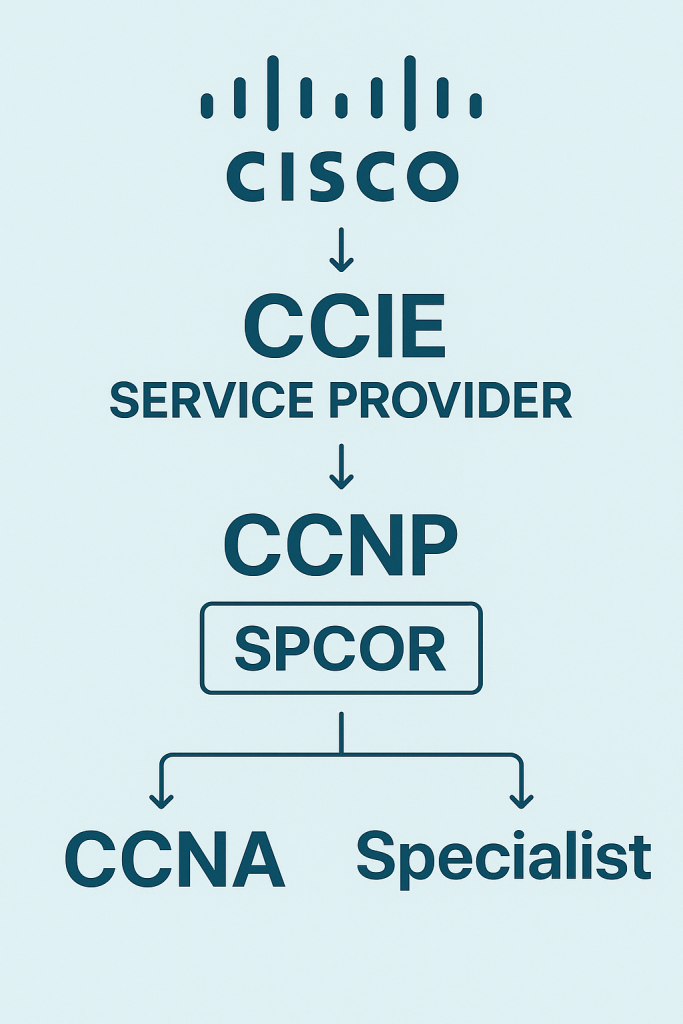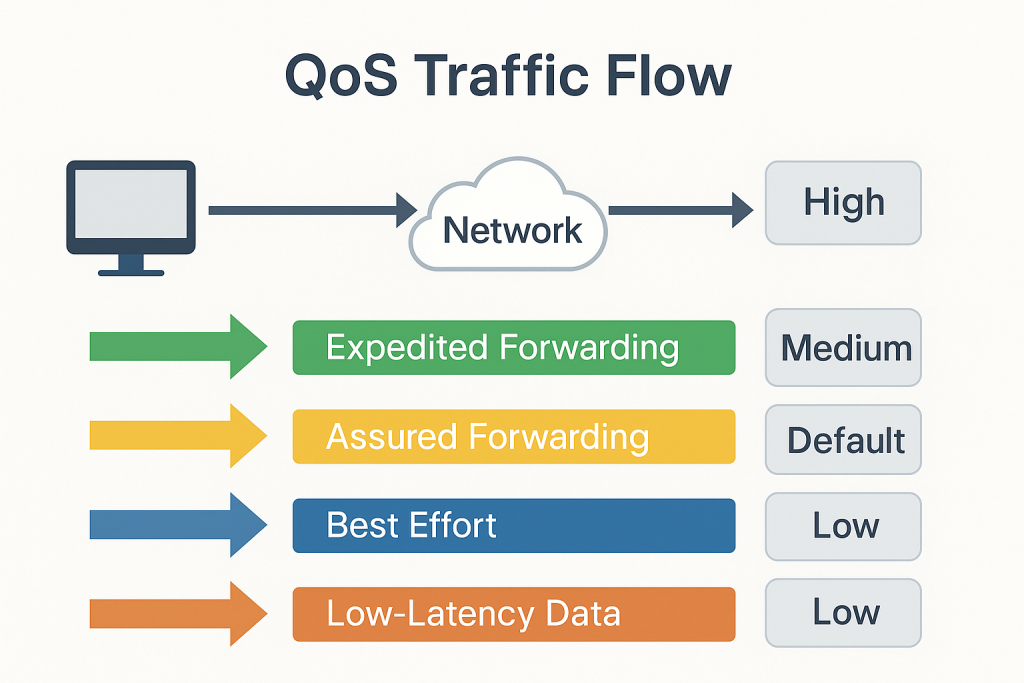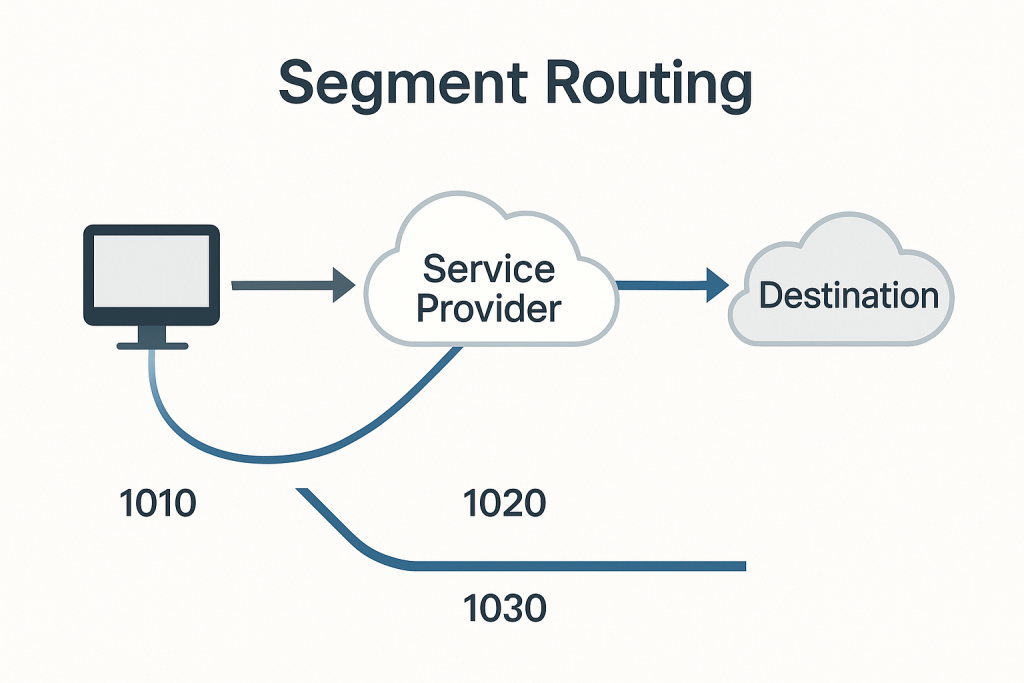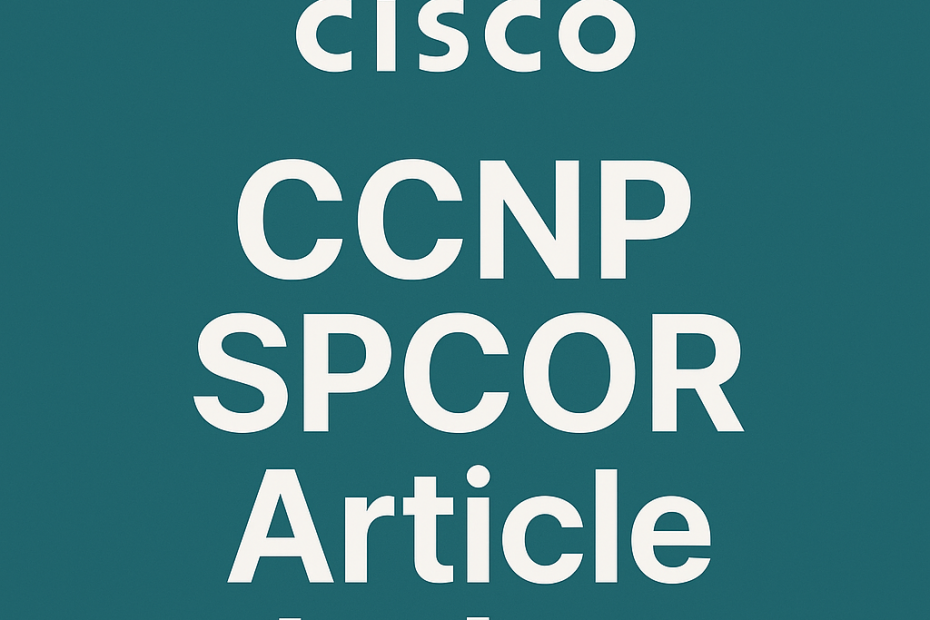Complete Blog Series

Right, let’s get straight to it. You’re here because you want to pass the Cisco CCNP SPCOR exam, and frankly, it’s not an easy one. I’ve been working with service provider networks for years, and I can tell you that this certification will test everything you think you know about networking and then some.
This blog series covers every single topic you need for the Cisco CCNP SPCOR 350-501 exam. No fluff, no marketing nonsense – just the technical knowledge you need to understand service provider networking and pass this challenging examination.

What You’re Getting Yourself Into
The Cisco CCNP Service Provider certification isn’t your typical networking exam. I’ve seen experienced engineers who can configure enterprise networks in their sleep struggle with service provider concepts. The reason? Service provider networking operates on a completely different scale and uses technologies that most people never encounter in corporate environments.
The CCNP SPCOR 350-501 exam is 120 minutes of questions that will test not just what you know, but how deeply you understand it. Cisco didn’t make this easy – they expect you to know the theory behind the technologies, be able to configure them on both IOS-XE and IOS-XR platforms, compare different approaches, and troubleshoot when things go wrong.
Here’s What the Exam Actually Tests
The exam breaks down into five main areas, and I need to be honest with you about what each one really means:
Architecture (15%) – This isn’t just drawing network diagrams. You need to understand how Metro Ethernet works, why MPLS exists, what SRv6 actually does, and how virtualisation fits into modern service provider networks. They’ll ask you about things like unified MPLS and routed optical networks.
Routing (35%) – This is the big one, and it’s where most people either pass or fail. We’re talking IS-IS, OSPF, and BGP at a level that goes far beyond enterprise networking. You need to understand how these protocols work when you’re routing traffic for millions of customers across continents. BGP alone could fill half the exam.
Transport Protocols (20%) – MPLS, segment routing, and traffic engineering. If you think MPLS is just about labels, you’re in for a surprise. Modern service provider networks use MPLS for everything from basic connectivity to complex traffic engineering solutions.
Services (15%) – Layer 2 and Layer 3 VPNs, multicast, and QoS. This is where you learn how service providers actually make money – by providing services to customers. EVPN, VPLS, L3VPNs, and multicast implementations that work at scale.
Automation and Assurance (15%) – The modern bit. NETCONF, RESTCONF, YANG, gRPC – all the programmable infrastructure that’s becoming essential in large-scale networks. Plus monitoring and telemetry that actually works when you’ve got thousands of devices.
The Path to CCNP Service Provider Certification
To earn your Cisco CCNP Service Provider certification, you must successfully complete two examinations:
- SPCOR 350-501 (covered in this blog series)
- One concentration exam of your choice:
- 300-510 SPRI – Advanced Routing Solutions
- 300-515 SPVI – VPN Services
- 300-535 SPAUTO – Automation Solutions
- 300-540 SPCNI – Cloud Network Infrastructure
Importantly, the SPCOR exam also serves as the qualifying examination for CCIE Service Provider, making this certification your gateway to networking’s most prestigious credential.

Why Learn Service Provider Networking?
Look, I’ll be straight with you. Service provider networking is harder than enterprise networking. The scale is different, the requirements are stricter, and the technologies are more complex. But there’s a reason for that complexity, and understanding it opens up career opportunities that most network engineers never see.
The Reality of Service Provider Networks
When you configure a router in a corporate network and it goes down, maybe a few hundred employees can’t access email. When a service provider router fails, potentially millions of people lose internet connectivity. That’s why these networks are built differently.
I’ve worked on networks where a single BGP misconfiguration could affect internet routing for entire countries. The BGP you learned in your CCNA studies? That’s just the beginning. Service provider BGP involves concepts like route reflectors, confederations, and communities that control how traffic flows across the entire internet.
MPLS isn’t just about labelling packets – it’s the foundation that makes modern telecommunications possible. Those L3VPNs that connect corporate offices worldwide? The EVPN networks that enable cloud connectivity? The traffic engineering that ensures your video calls don’t break up during peak hours? All built on MPLS and segment routing technologies.
Where This Knowledge Takes You
The skills you’ll learn here aren’t just for passing an exam. Here’s where you can actually use this stuff:
Internet Service Providers – The companies that provide internet connectivity to homes and businesses. BT, Virgin Media, Sky – they all run networks based on these technologies.
Mobile Network Operators – Ever wondered how your phone connects to the internet through 4G or 5G? The backhaul networks that connect mobile towers use service provider technologies.
Cloud Providers – AWS, Microsoft Azure, Google Cloud – their global networks use many of the same technologies you’ll learn here. Understanding BGP and MPLS opens doors to roles at these companies.
Large Enterprises – Big companies often build their own service provider-style networks. Banks, retailers, and government organisations need people who understand how to build and operate carrier-grade networks.
Network Consulting – Once you understand these technologies, you can help other organisations design and implement large-scale networks.
The Technologies That Actually Matter
Here’s what you’ll really be learning, stripped of the marketing nonsense:
MPLS and Segment Routing – How to move packets efficiently across large networks whilst providing guaranteed service levels. Segment routing is the modern evolution of MPLS, and it’s what new networks are being built with.
Advanced Routing – BGP that scales to internet-size routing tables, IS-IS and OSPF implementations that handle thousands of routers, and routing policies that control how traffic flows across networks.
VPN Services – How service providers connect customer sites together. Layer 2 services like E-Line and E-LAN, Layer 3 VPNs that connect offices, and EVPN that’s revolutionising data centre networking.
Quality of Service – Traffic prioritisation that actually works when you’ve got different customers sharing the same network infrastructure. Voice, video, and data all need different treatment.
Network Automation – APIs, YANG models, and programmable infrastructure that let you manage thousands of devices without going insane.
The bottom line? These technologies run the internet and the global telecommunications infrastructure. Understanding them puts you in a different category of network engineer.
My Teaching Philosophy
This blog series adopts a practical, hands-on approach to learning service provider technologies. Each post combines theoretical foundations with real-world implementation examples, ensuring you understand not just what these technologies do, but how and why they work in production environments.
What Makes This Series Different
Comprehensive Coverage: Every examination topic receives detailed treatment across 132 specialised blog posts, ensuring no stone is left unturned.
Practical Implementation: Configuration examples for both Cisco IOS-XE and IOS-XR platforms, reflecting real service provider environments.
Industry Context: Each technology is presented with genuine use cases, benefits, and limitations drawn from production networks.
Exam-Focused: Content specifically aligned with CCNP SPCOR examination requirements, including the depth expected for “Describe,” “Compare,” “Configure,” and “Troubleshoot” question types.

Complete Blog Series Structure
The entire series is organised into 23 comprehensive sections, each covering specific aspects of service provider networking. Below you’ll find the complete roadmap for your CCNP SPCOR journey.
Part I: Service Provider Core Architectures
The foundation of service provider networking begins with understanding core architectural principles. These six posts establish essential knowledge about Metro Ethernet, MPLS, and modern routing paradigms.
Blog 1: Metro Ethernet Fundamentals – E-Line, E-Tree, E-LAN, and E-Access Services Exam Domain: 1.1.a
Blog 2: MPLS Core Architecture – Label Switching Fundamentals and LSP Operations Exam Domain: 1.1.a
Blog 3: Unified MPLS Architecture – Seamless MPLS for Large-Scale Networks Exam Domain: 1.1.a
Blog 4: Segment Routing Overview – Introduction to SR, SRTE, and Modern MPLS Alternatives Exam Domain: 1.1.a
Blog 5: SRv6 Architecture – IPv6-Based Segment Routing for Next-Generation Networks Exam Domain: 1.1.a
Blog 6: Routed Optical Networks – Integrating IP and Optical Transport Technologies Exam Domain: 1.1.d
Part II: Transport Technologies
Understanding the physical layer technologies that underpin service provider networks is crucial for CCNP-level engineers. These five posts cover the diverse access and transport methods used across different service provider scenarios.
Blog 7: xDSL Technologies – ADSL, VDSL, and Broadband Access Network Design Exam Domain: 1.1.b
Blog 8: Dense Wavelength Division Multiplexing (DWDM) – High-Capacity Optical Transport Exam Domain: 1.1.b
Blog 9: DOCSIS Technology – Cable Modem Infrastructure and Service Delivery Exam Domain: 1.1.b
Blog 10: Time Division Multiplexing (TDM) – Legacy Circuit-Switched Transport Exam Domain: 1.1.b
Blog 11: xPON Technologies – Passive Optical Networks and Fibre Access Exam Domain: 1.1.b
Part III: Mobility and Core Networks
Modern service provider networks must support mobile communications infrastructure. These four posts explore packet core, radio access networks, and 5G transport requirements.
Blog 12: Packet Core Networks – EPC Architecture and Mobile Infrastructure Exam Domain: 1.1.c
Blog 13: RAN Transport – Radio Access Network Connectivity Solutions Exam Domain: 1.1.c
Blog 14: 5G vRAN Transport – Virtualised Radio Access Network Implementation Exam Domain: 1.1.c
Blog 15: ORAN Transport – Open Radio Access Network Architecture Exam Domain: 1.1.c
Part IV: Cisco Network Software Architecture
Understanding the software platforms that power modern service provider equipment is essential. These three posts cover the operating systems and architectural differences you’ll encounter.
Blog 16: Cisco IOS Architecture – Monolithic Operating System Fundamentals Exam Domain: 1.2.a
Blog 17: Cisco IOS-XE Architecture – Modular Operating System Design Exam Domain: 1.2.b
Blog 18: Cisco IOS-XR Architecture – Carrier-Grade Operating System Exam Domain: 1.2.c
Part V: Service Provider Virtualisation
Network functions virtualisation represents a fundamental shift in service provider architecture. These four posts explore NFV, containers, and application hosting in modern networks.
Blog 19: NFV Infrastructure – Network Functions Virtualisation Foundation Exam Domain: 1.3.a
Blog 20: VNF Workloads – Virtual Network Functions and Service Chaining Exam Domain: 1.3.b
Blog 21: Container Technologies – Docker, Kubernetes, and Orchestration Exam Domain: 1.3.c
Blog 22: Application Hosting – Edge Computing and Service Deployment Exam Domain: 1.3.d
Part VI: QoS Architecture
Quality of Service implementation in service provider networks requires understanding multiple models and approaches. These six posts cover the essential QoS frameworks and technologies and will be tested in the CCNP SPCOR exam.
Blog 23: MPLS QoS Models – Pipe, Short Pipe, and Uniform Models Explained Exam Domain: 1.4.a
Blog 24: MPLS Traffic Engineering QoS – MAM, RDM, CBTS, PBTS, and DS-TE Exam Domain: 1.4.b
Blog 25: Differentiated Services (DiffServ) – DSCP Marking and Per-Hop Behaviours Exam Domain: 1.4.c
Blog 26: Integrated Services (IntServ) – RSVP and Resource Reservation Exam Domain: 1.4.c
Blog 27: QoS Trust Boundaries – Enterprise-Service Provider QoS Demarcation Exam Domain: 1.4.d
Blog 28: IPv6 Flow Label – Traffic Classification and QoS in IPv6 Networks Exam Domain: 1.4.e

Routing Protocols Deep Dive
The routing section represents the largest portion of the CCNP SPCOR examination (35%) and covers both Interior Gateway Protocols (IGP) and Border Gateway Protocol (BGP) in extensive detail.
Part VII: Routing Fundamentals and IS-IS
Blog 29: Service Provider Routing Fundamentals – IGP vs EGP Design Considerations Exam Domain: 2.1
Blog 30: IS-IS Route Advertisement – LSP Generation and Database Synchronisation Exam Domain: 2.1.a
Blog 31: IS-IS Area Design – Level-1, Level-2, and Multi-Area Implementation Exam Domain: 2.1.b
Blog 32: IS-IS Neighbour Relationships – Adjacency Formation and Maintenance Exam Domain: 2.1.c
Blog 33: IS-IS Prefix Advertisement – Route Origination and Redistribution Exam Domain: 2.1.d
Blog 34: IS-IS Troubleshooting – Common Issues and Resolution Techniques Exam Domain: 2.6.a
Part VIII: OSPF Implementation
Blog 35: OSPF Area Design – Backbone, Standard, and Special Area Types Exam Domain: 2.2.a
Blog 36: OSPF Neighbour Relationships – DR/BDR Election and Adjacency States Exam Domain: 2.2.b
Blog 37: OSPF Prefix Advertisement – Network Statements and Route Injection Exam Domain: 2.2.c
Blog 38: OSPF Route Types – Intra-Area, Inter-Area, and External Routes Exam Domain: 2.2.d
Blog 39: OSPF LSA Types – Understanding Link State Advertisements Exam Domain: 2.2.e
Blog 40: OSPF Troubleshooting – Diagnosing Adjacency and Routing Issues Exam Domain: 2.6.a
Part IX: BGP Fundamentals and Optimisation
Blog 41: BGP Neighbour Relationships – iBGP, eBGP, and Peering Configuration Exam Domain: 2.4.a
Blog 42: BGP Prefix Advertisement – Network Statements and Redistribution Methods Exam Domain: 2.4.b
Blog 43: BGP Address Families – IPv4, IPv6, VPNv4, and VPNv6 Implementation Exam Domain: 2.4.c
Blog 44: BGP Path Selection – Local Preference, MED, and AS Path Manipulation Exam Domain: 2.4.d
Blog 45: BGP Attributes – Well-Known, Optional, and Community Attributes Exam Domain: 2.4.e
Blog 46: BGP Route Redistribution – IGP to BGP Best Practices Exam Domain: 2.4.f
Blog 47: BGP Additional Paths – Add-Path Advertisement and Path Diversity Exam Domain: 2.4.g
Blog 48: BGP Prefix Independent Convergence – Fast Convergence Mechanisms Exam Domain: 2.4.h
MPLS and Advanced Transport
The transport protocols section covers the core technologies that differentiate service provider networks from enterprise environments.
Part XIII: MPLS Implementation
Blog 64: MPLS Label Distribution Protocol – LDP Fundamentals and Configuration Exam Domain: 3.1
Blog 65: LDP Synchronisation – IGP-LDP Coordination for Traffic Protection Exam Domain: 3.1.a
Blog 66: LDP Session Protection – Targeted LDP Sessions and Resilience Exam Domain: 3.1.b
Blog 67: LDP Neighbours and Discovery – Hello Mechanisms and Adjacency Exam Domain: 3.1.c
Blog 68: Unified MPLS Implementation – Seamless MPLS Configuration Exam Domain: 3.1.d
Blog 69: MPLS Operations and Maintenance – OAM Tools and Troubleshooting Exam Domain: 3.1.e
Part XIV: MPLS Traffic Engineering
Blog 70: Traffic Engineering Concepts – Bandwidth Optimisation and Constraint-Based Routing Exam Domain: 3.2
Blog 71: IS-IS and OSPF TE Extensions – IGP Support for Traffic Engineering Exam Domain: 3.2.a
Blog 72: RSVP-TE Fundamentals – Resource Reservation and Signalling Exam Domain: 3.2.b
Blog 73: Fast Reroute (FRR) – Link and Node Protection Mechanisms Exam Domain: 3.2.c
Part XV: Segment Routing
Blog 74: Segment Routing Segment Types – Adjacency, Node, and Service Segments Exam Domain: 3.3.a
Blog 75: SR Control Plane with BGP – BGP-LS and SR Policy Advertisement Exam Domain: 3.3.b
Blog 76: SR Control Plane with OSPF – OSPF Extensions for Segment Routing Exam Domain: 3.3.b
Blog 77: SR Control Plane with IS-IS – IS-IS Extensions for Segment Routing Exam Domain: 3.3.b
Blog 78: Segment Routing Traffic Engineering – Policy-Based Routing Exam Domain: 3.3.c
Blog 79: TI-LFA – Topology Independent Loop-Free Alternate Exam Domain: 3.3.d
Blog 80: PCE-PCC Architectures – Path Computation Element Implementation Exam Domain: 3.3.e
Blog 81: Flexible Algorithm – Customised IGP Shortest Path Calculations Exam Domain: 3.3.f
Blog 82: SRv6 Deep Dive – Locators, Micro-Segments, and Encapsulation Exam Domain: 3.3.g

Service Provider Services
Understanding how service providers deliver connectivity services to customers represents a crucial aspect of CCNP SPCOR knowledge.
Part XVI: Layer 2 VPN Services
Blog 83: Ethernet Services Overview – E-Line, E-Tree, E-Access, and E-LAN Exam Domain: 4.2.a
Blog 84: VPWS Implementation – Point-to-Point Layer 2 VPN Services Exam Domain: 4.2.a
Blog 85: VPLS Configuration – Multipoint Layer 2 VPN Services Exam Domain: 4.2.a
Blog 86: IEEE 802.1ad Provider Bridges – Q-in-Q VLAN Stacking Technology Exam Domain: 4.2.b
Blog 87: IEEE 802.1ah Provider Backbone Bridges – MAC-in-MAC Encapsulation Exam Domain: 4.2.b
Blog 88: ITU-T G.8032 Ethernet Ring Protection – Ring-Based Redundancy Exam Domain: 4.2.b
Blog 89: Ethernet OAM – Connectivity Fault Management Exam Domain: 4.2.c
Blog 90: VLAN Tag Manipulation – Service Provider VLAN Processing Exam Domain: 4.2.d
Part XVII: EVPN Services
Blog 91: EVPN Fundamentals – Ethernet VPN Architecture and Route Types Exam Domain: 4.1.a
Blog 92: EVPN VXLAN – Network Virtualisation Overlay Implementation Exam Domain: 4.1.a
Blog 93: EVPN Multihoming – All-Active and Single-Active Redundancy Exam Domain: 4.1.a
Part XVIII: Layer 3 VPN Services
Blog 94: MPLS L3VPN Fundamentals – PE-CE Routing and VRF Implementation Exam Domain: 4.3.a
Blog 95: Inter-AS VPN Options – Option A, B, and C Implementation Exam Domain: 4.1.b
Blog 96: Carrier Supporting Carrier – Hierarchical VPN Services Exam Domain: 4.1.c
Blog 97: L3VPN Shared Services – Internet and Extranet Access Exam Domain: 4.3.b
Part XIX: Multicast Services
Blog 98: PIM-SM Implementation – Sparse Mode Protocol Configuration Exam Domain: 4.4.a
Blog 99: PIM-SSM Configuration – Source-Specific Multicast Deployment Exam Domain: 4.4.a
Blog 100: PIM-BIDIR Implementation – Bidirectional PIM Configuration Exam Domain: 4.4.a
Blog 101: PIMv6 Configuration – IPv6 Multicast Protocol Implementation Exam Domain: 4.4.a
Blog 102: IGMP and MLD – Multicast Group Management Protocols Exam Domain: 4.4.b
Blog 103: Multicast VPN (mVPN) – Multicast Services over MPLS Exam Domain: 4.1.d
Part XX: QoS Services Implementation
Blog 104: QoS Classification and Marking – Traffic Identification Methods Exam Domain: 4.5.a
Blog 105: Congestion Avoidance – WRED, ECN, and Buffer Management Exam Domain: 4.5.b
Blog 106: Traffic Policing and Shaping – Rate Limiting and Conditioning Exam Domain: 4.5.b
Security and Automation
The final sections cover essential operational aspects of the CCNP SPCOR exam.
Part XXI: Control Plane Security
Blog 107: Control Plane Protection (CoPP) – Rate Limiting and Access Control Exam Domain: 1.5.a
Blog 108: Local Packet Transport Services (LPTS) – IOS-XR Control Plane Protection Exam Domain: 1.5.a
Blog 109: BGP TTL Security – Time-to-Live Based Protection Mechanisms Exam Domain: 1.5.b
Blog 110: BGP Protocol Authentication – MD5 and Keychain Authentication Exam Domain: 1.5.b
Blog 111: BGP Prefix Suppression – Hiding BGP Prefixes for Security Exam Domain: 1.5.c
Blog 112: LDP Security – Authentication and Label Allocation Filtering Exam Domain: 1.5.d
Blog 113: BGPsec and BGP Flowspec – Enhanced BGP Security Mechanisms Exam Domain: 1.5.e, 1.5.f
Part XXII: Management and Data Plane Security
Blog 114: Traceback Techniques – Identifying Attack Sources and Traffic Origins Exam Domain: 1.6.a
Blog 115: AAA and TACACS – Authentication, Authorisation, and Accounting Exam Domain: 1.6.b
Blog 116: REST API Security – Securing Programmatic Network Access Exam Domain: 1.6.c
Blog 117: DDoS Protection – Distributed Denial of Service Mitigation Strategies Exam Domain: 1.6.d
Blog 118: Unicast Reverse Path Forwarding (uRPF) – Spoofing Prevention Exam Domain: 1.7.a
Blog 119: Access Control Lists (ACLs) – Packet Filtering and Traffic Control Exam Domain: 1.7.b
Blog 120: Remote Triggered Black Hole (RTBH) – DDoS Mitigation Technique Exam Domain: 1.7.c
Blog 121: Media Access Control Security (MACsec) – Layer 2 Encryption Exam Domain: 1.7.d
Part XXIII: Automation and Assurance
Blog 122: REST APIs for Network Automation – RESTful Web Services and JSON Exam Domain: 5.1, 5.2
Blog 123: NETCONF Protocol – Network Configuration Protocol Implementation Exam Domain: 5.9
Blog 124: RESTCONF Protocol – RESTful Interface to NETCONF Datastores Exam Domain: 5.9
Blog 125: YANG Data Modeling – Network Device Configuration and State Modeling Exam Domain: 5.4
Blog 126: gRPC and gNMI – High-Performance RPC and Network Management Interface Exam Domain: 5.7
Blog 127: Network Services Orchestrator (NSO) – Service Lifecycle Management Exam Domain: 5.3
Blog 128: Secure Zero Touch Provisioning (ZTP) – Automated Device Deployment Exam Domain: 5.6
Blog 129: NetFlow and IPFIX – Network Traffic Analysis and Monitoring Exam Domain: 5.8
Blog 130: Streaming Telemetry – Real-Time Network Monitoring and Analytics Exam Domain: 5.8
Blog 131: SNMP v2c and v3 – Simple Network Management Protocol Implementation Exam Domain: 5.10
Blog 132: Ansible and Terraform – Infrastructure as Code for Network Automation Exam Domain: 5.5

How to Use This Blog Series
For Exam Preparation
Structured Learning Path: Follow the blog series in order, as each post builds upon previous knowledge. The sequence mirrors the logical progression of service provider networking concepts.
Hands-On Practice: Each post includes configuration examples for both IOS-XE and IOS-XR. Set up lab environments to practice these configurations.
Exam Mapping: Every blog post clearly indicates which exam domain it covers, helping you track your progress against the official examination blueprint.
Review and Reinforcement: Use the series as a reference during your revision phase, focusing on areas where you need additional understanding.
For Professional Development
Real-World Context: Beyond exam preparation, these posts provide practical insights for implementing service provider technologies in production environments.
Technology Evolution: Stay current with emerging technologies like SRv6, EVPN, and network automation that represent the future of service provider networking.
Career Advancement: The knowledge gained supports progression into senior network engineering roles, solution architecture positions, and technical consulting opportunities.
Additional Resources and External Learning
While this blog series provides comprehensive coverage of CCNP SPCOR topics, supplementing your learning with additional resources enhances understanding and provides alternative perspectives.
Recommended External Resource: Cisco Learning Network CCNP Service Provider Community – An excellent platform for connecting with other certification candidates, accessing additional study materials, and participating in technical discussions with Cisco experts and community members.
The Cisco Learning Network provides valuable resources including practice questions, study groups, and expert-moderated forums where you can ask questions and share experiences with fellow learners pursuing CCNP SPCOR certification.
Success Strategies for CCNP SPCOR
Practical Preparation Tips
Labbing: Service provider technologies require hands-on experience. Whether using physical equipment, virtualisation platforms, or cloud-based labs, ensure you gain practical configuration experience.
Study Schedule: With 132 blog posts covering complex topics, establish a consistent study routine. Allow sufficient time for both reading and practical implementation.
Community Engagement: Join networking communities, attend local user groups, and participate in online forums to discuss technologies and share experiences.
Real-World Application: Where possible, relate the technologies to your current work environment or seek opportunities to observe service provider networks in operation.
Understanding Exam Expectations
The CCNP SPCOR examination tests knowledge at four distinct levels:
- Describe: Fundamental understanding of concepts and architectures
- Compare: Ability to differentiate between similar technologies
- Configure: Practical implementation skills and syntax knowledge
- Troubleshoot: Advanced problem-solving capabilities
Each blog post addresses these competency levels, ensuring comprehensive preparation for examination success.
Staying Connected
This index page will be regularly updated as new blog posts become available. Each entry above will be converted to a direct link once the corresponding post is published, creating a seamless navigation experience.
Internal Linking Strategy: As the series develops, posts will include extensive cross-references, helping you understand the interconnected nature of service provider technologies and supporting your learning journey.
Feedback and Questions: Your input helps improve this educational resource. Comments, questions, and suggestions for additional topics are always welcome.
Your CCNP SPCOR Journey Begins Here
Service provider networking represents one of the most challenging and rewarding areas of network engineering. The technologies you’ll master through this blog series power the global communications infrastructure that connects billions of users worldwide.
Whether you’re preparing for the CCNP SPCOR examination, advancing your career in service provider networking, or simply expanding your technical knowledge, this comprehensive blog series provides the depth and practical focus needed for success.
The journey to CCNP Service Provider certification is demanding, but the knowledge gained opens doors to exciting career opportunities in telecommunications, cloud computing, and network infrastructure. Each blog post brings you closer to mastering the complex technologies that keep our connected world functioning.
Begin your journey today by diving into the foundational architectures that underpin modern service provider networks. Your future in service provider networking starts here.

Pingback: Cisco CCNP SPCOR Blog 4 Segment Routing Overview - RichardKilleen
Pingback: Cisco CCNP SPCOR Blog 11: Passive Optical Networks or PON - RichardKilleen